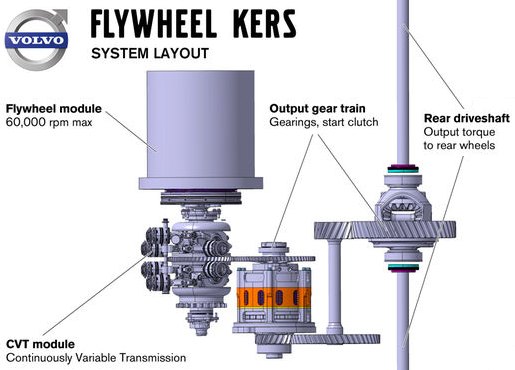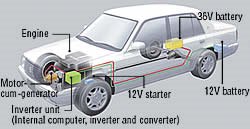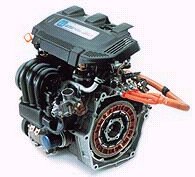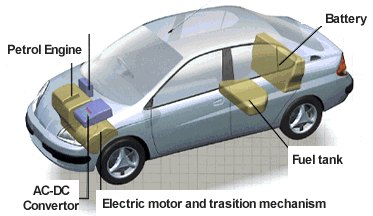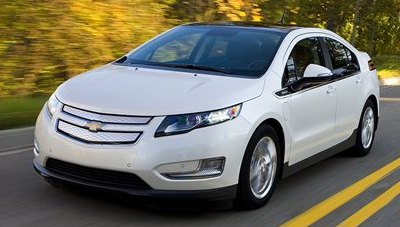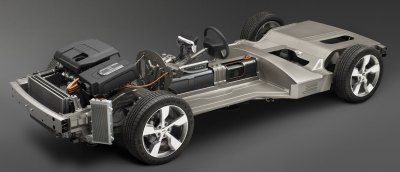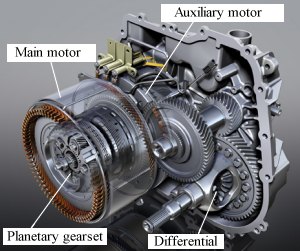|
AUTOZINE TECHNICAL SCHOOL
Hybrid Cars All cars need energy for propulsion. When
they decelerate and stop, the energy is wasted in braking. Why not
recapture the braking energy, store it and use it for acceleration
later on? That is exactly the rationale behind hybrid cars. Since
hybrid cars improve fuel efficiency by using regenerative braking,
they show strong advantage over conventional cars in urban driving
where frequent start-stop is expected. On the contrary, when running at
steady speed on highway, they save no fuel.
Most hybrid cars use battery as storage device and electric motors for regenerative braking and propulsion assist. There are other options. Mazda, for example, uses supercapacitor instead of battery in its i-Eloop mild-hybrid/stop-start system. Some of the earliest KERS (Kinetic Energy Recovery System) used by Formula One race cars employed flywheel system, which is purely mechanical. However, none of them could match the energy capacity of battery, so they fail to challenge battery hybrid system on road car applications. Mechanical Hybrid Volvo Flywheel KERS
(2011)
In 2006, to promote fuel-efficient technology, FIA decided to introduce KERS (Kinetic Energy Recovery System) to Formula One from the 2009 season. The problem was, conventional battery hybrid power systems would have weighed too much and provided too little instantaneous power. A few Renault F1 engineers thought of a pure mechanical solution: use a fast-spinning flywheel to store the kinetic energy. It would be much lighter, simpler and more powerful. Consequently, they founded an engineering company called Flybrid to develop the Flywheel KERS technology for F1 and Le Mans cars, and later on also road cars. As of the time of writing, Flywheel KERS has yet to be adopted on production road cars. However, Volvo was probably the closest to get there. It had been testing an S60 T5 prototype fitted with Flybrid's system since 2011. The whole system added only 60 kg to the S60. It consists of a flywheel module, CVT and a gear set coupling to the rear axle:
On the S60 T5, Volvo said the system is able to cut 0-62 mph from 7 to 5.5 sec and reduce fuel consumption by up to 25 percent – admittedly, the latter takes urban driving with congested traffic to realize. Compared with battery hybrid system, Flywheel KERS stores little energy as its energy density (Wh per kg) is much lower. The Volvo unit stores an estimated 600kJ, which equals to 0.167 kWh. For comparison, Toyota Prius Mk4 employs a 0.7 kWh battery, or 4 times the capacity. Moreover, the energy stored in flywheel fades out quickly, unlike battery, so to utilize the stored energy, frequent acceleration-deceleration is a must. To race cars, this won't be a problem because every corner presents opportunity to decelerate and accelerate. For normal road driving, the benefit will be much smaller. On the positive side, flywheel KERS has much higher power density (power per kg) than battery, so it is more suitable to performance cars and race cars. Mild Hybrid Toyota Crown mild hybrid
(2002)
Toyota is known for Prius, but it is also the first to put mild hybrid technology to mass production. The 2002 Crown was the first application of the THS-M (Toyota Hybrid System-Mild) system.
Since the electric motor and battery are small, mild hybrid cars cannot rely on purely battery power for moving. The engine always needs to work in propulsion, although some fuel can be saved as the electric motor shares some work in acceleration. Compared with full hybrid cars, mild hybrid saves less fuel, but the additional cost and weight are also much smaller. Best of all, it is easily compatible with existing cars. Honda Insight (1999)  Launched in 1999, Honda Insight was the
world's second hybrid production car (after Toyota Prius). Strictly
speaking it was a mild hybrid, because its electric motor was not
powerful enough to propel the car alone. Its IMA (Integrated Motor
Assist) hybrid system was very compact, taking no more space than a
conventional 4-cylinder engine. A disc-shaped DC brushless motor with a
thickness of merely 60mm was mated next to the 1.0-liter 3-cylinder
engine. They provided 13.6 hp and 70 hp respectively, while combined
output was 78 hp. During regenerative braking, the DC motor acted as
generator and recharge the battery. The 144V NiMH battery weighed 20 kg
and was mounted under the boot. Launched in 1999, Honda Insight was the
world's second hybrid production car (after Toyota Prius). Strictly
speaking it was a mild hybrid, because its electric motor was not
powerful enough to propel the car alone. Its IMA (Integrated Motor
Assist) hybrid system was very compact, taking no more space than a
conventional 4-cylinder engine. A disc-shaped DC brushless motor with a
thickness of merely 60mm was mated next to the 1.0-liter 3-cylinder
engine. They provided 13.6 hp and 70 hp respectively, while combined
output was 78 hp. During regenerative braking, the DC motor acted as
generator and recharge the battery. The 144V NiMH battery weighed 20 kg
and was mounted under the boot.The Insight had long been the most fuel efficient car on the market. Its fuel consumption was rated at 3.4 liter/100km or 83 mpg in EU, while CO2 emission was merely 80 grams each km. Apart from the IMA, thanks must be given to also its slippery shape (Cd 0.25), compact size (it's a 2-seater) and lightweight construction (835 kg kerb weight).
Honda continued to develop the IMA system for the second generation Insight (2009) and the next 3 generations of Civic Hybrid (2002, 2006 and 2011) but the concept remained largely the same. The main improvement was more powerful motor, which relieved the work of the engine and, from the 2006 Civic Hybrid, eventually allowed pure electric propulsion under very light load. Compared with the full hybrid system of Toyota Prius, the IMA is more compact, simpler and cheaper to build. On the downside, it is not as efficient. As the electric motor is weak, the engine has to work permanently in propulsion. Moreover, the electric motor is permanently connected to the engine without a clutch, so even when the car is driven by engine alone, it wastes some power to spin the motor. Vice versa, when the electric motor provides all the power, it waste some power to spin the engine. Auto stop-start with brake energy regeneration In recent years, mild hybrid system becomes popular in the form of automatic engine stop-start. European NEDC driving cycle includes a number of stop-start patterns simulating traffic jams in urban driving. In such conditions, the use of automatic engine stop-start system can cut fuel consumption and emission. It uses an Integrated Starter Generator (ISG) in place of both motor starter and alternator. When the car comes to a stop, the ISG captures the braking energy into the battery. The engine is then shut down automatically. During this period, electricity demand (including the power-sapping air-con) is fulfilled by the battery. When the driver presses the throttle pedal, the ISG restarts the engine. Automatic engine stop-start with brake energy regeneration has been used extensively on BMW cars since 2007. The recaptured brake energy is used to power the car’s electrical system rather than propelling the car, so it is arguable whether it is a mild hybrid. Anyway, BMW said it reduces fuel consumption by 3 percent. GM’s eAssist goes one step further. It uses a larger ISG and a 115V lithium-ion battery to provide propulsion assistance. The ISG is connected to the engine crankshaft through a belt drive. It can contribute up to 15 hp and 79 lbft of torque to the powertrain. Full Hybrid Toyota Prius (1997) 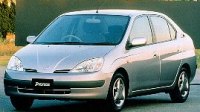 In 1997, Toyota launched
the world's first hybrid production car, Prius. It was claimed to cut fuel
consumption and CO2 emission by 50
percent, and reduce pollutants by 90 percent. Its THS (Toyota Hybrid
System) hybrid powertrain consisted of a 1.5-liter Atkinson-cycle
engine and 2 AC induction motors. They were made compact enough to be
mated
in-line, mounted transversely in the engine compartment and drove the
front wheels like conventional FF cars. The power electronics sat above
the transmission and motors. The battery was mounted in the boot, while
a small fuel tank rested under the rear seat. The packaging was so
clever that the Prius actually offered more cabin space than its
exterior size suggested. The only drawback was a smaller boot. In 1997, Toyota launched
the world's first hybrid production car, Prius. It was claimed to cut fuel
consumption and CO2 emission by 50
percent, and reduce pollutants by 90 percent. Its THS (Toyota Hybrid
System) hybrid powertrain consisted of a 1.5-liter Atkinson-cycle
engine and 2 AC induction motors. They were made compact enough to be
mated
in-line, mounted transversely in the engine compartment and drove the
front wheels like conventional FF cars. The power electronics sat above
the transmission and motors. The battery was mounted in the boot, while
a small fuel tank rested under the rear seat. The packaging was so
clever that the Prius actually offered more cabin space than its
exterior size suggested. The only drawback was a smaller boot.
STARTING: The Prius always started with electric motor only. It skipped the engine because the heavy load in standing start could result in high fuel consumption and a lot of emission pollutants. By delaying the intervention of engine, its electrically-heated catalyst had sufficient time to get up to operating temperature. ACCELERATION: When the car got up to a certain speed, the engine started to keep the car accelerating. As the electric motor eased the load taken by the engine, fuel consumption and emission remained low. STEADY CRUISING: As long as the battery had juice left, the car would be powered by both engine and motor. In case of low speed cruising, the engine could be shut down to save fuel. BRAKING /
DOWNHILL: The second motor was engaged. It acted as a generator,
converting the kinetic energy to electricity and recharge the battery.
Meanwhile, the negative torque it produced helped slowing down the
car. Toyota
renamed the
THS to HSD (Hybrid Synergy Drive) in the second generation
Prius, but its basic design remained unchanged. Over the years, its
engine and electric motors got more powerful and efficient. Until today
it remains to be the most efficient hybrid design. Plug-in Hybrid Chevrolet Volt (2010) Plug-in hybrid (PHEV) works just like full hybrid cars, but it uses a much larger battery to provide enough range for daily commutes. The motor is also more powerful so that it doesn’t need to start the engine in most driving conditions. Moreover, the battery can be charged through power sockets at home or charging facilities, so many trips could be completed on electric power alone without burning a drop of fuel. The engine is used only when the car runs out of battery, allowing the car to extend its range and to be refilled at gas stations. Therefore, the engine is also called "range-extender". As PHEV works like an EV most of the time, it is generally greener than hybrids (see the Electric Cars section).
The world's first production PHEV was the 2008 BYD F3DM, but its technology was not very matured thus only a few thousand cars were sold. In my opinion, the first successful PHEV has to be General Motors' Chevrolet Volt, as it sold 100,000 units during the lifespan of its first generation.
The control system automatically selected from 4 operation modes: 1. EV mode for low speed (up to 70 mph): only the main motor was engaged, so all power came from the 149hp motor. 2. EV mode for high speed (up to 100 mph): both motors were engaged to provide power. The combined output was still regulated at 149hp, but running two motors at lower rev was more energy efficient than running only the main motor at high rev. 3. Range extending mode for low speed (up to 70 mph): when battery ran low, the engine started working. It drove the auxiliary motor, which acted as generator and was decoupled from the gearset, to generate electricity and supply the main traction motor. As a result, the car was powered by the main motor. Since the 84hp engine could not generate enough power to realize the main motor's 149hp output, this mode worked at below 70 mph. However, in case of overtaking or ascending, the combination of engine power and battery reserve might still allow short bursts of full power. 4. Range extending mode for high speed (up to 100 mph): all clutches were engaged. Now the engine was mechanically connected to the gearset via the auxiliary motor. The latter still worked as generator to supply the main traction motor. However, the majority output came directly from the engine. The second generation Volt, launched in 2015, kept refining the Voltec system. Chief improvements included a more powerful and efficient engine, torquier motors and larger capacity battery. The transmission, motors, power electronics and battery got lighter, as was the whole car. EV range improved to 53 miles as a result. Hybrid Transmission Planetary CVT Pioneered by Toyota Prius, most full hybrid cars (including Honda, Ford and GM's) use planetary CVT gearboxes to combine both power sources and vary transmission ratio. It is a complicated but clever idea. The picture below illustrates the system architecture of Toyota Prius. The powertrain consists of engine, electric motor MG1 (which normally acts as generator), electric motor MG2 (works mainly as propulsion motor), a planetary gearset called "Power Split Device", inverters and battery. 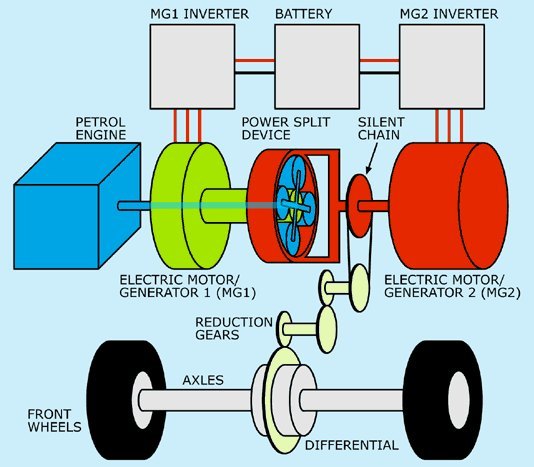 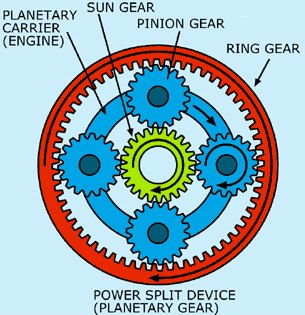 The engine crankshaft is connected rigidly to the planetary carrier (blue part), which drives the pinion gears. The pinion gears drive the outer ring gear (red part) and the inner sun gear (green part) simultaneously. The ring gear is connected to front wheels through some reduction gears. The sun gear is connected to MG1. Therefore, the engine's power is divided into two paths, one goes to the generator MG1, and another goes to the wheels. Meanwhile, the motor MG2 connects permanently to the ring gear (red) and drives the wheels directly. As a result, both the engine and MG2 can provide power to the wheels. How does it vary the transmission ratio to optimize the engine's rev and torque to match the wheel speed? The answer lies on the generator MG1. Assuming the green sun gear is fixed, the blue planetary gears run around the sun gear and drive the red ring gear, whose rotation is coupled to the wheels. In this case, the ratio between engine rev and wheel speed is fixed. Now, if we let the green sun gear to rotate in the same direction as the blue planetary carrier, the red ring gear will slow down. This means, the wheel speed is reduced in relation to the engine rev. It is effectively equals to shifting to a lower gear. Where does the excess power goes? It is used to spin the generator MG1, which may use the electric power to recharge the battery or to drive the motor MG2, which contributes to the propulsion power. The faster the generator MG1 is allowed to spin, the more power it generates, and the MG2 provides more propulsion power. Interestingly, if the battery does not take or contribute power to the system (e.g. during extended cruising), all of the MG2 power actually comes from the engine. The more power the engine transfers to MG1 and then electrically to MG2, the less power the engine directly transfers to the wheels. By controlling the current flowing through the MG1 and MG2, you can alter the speed of the sun gear, hence the transmission ratio and the proportion between engine/motor power. As the transmission ratio could be varied infinitely, the hybrid planetary gearbox is seen as a special kind of CVT (Continuous Variable Transmission). |
|||||||||||||||
| Copyright© 1997-2017 by Mark Wan @ AutoZine |
